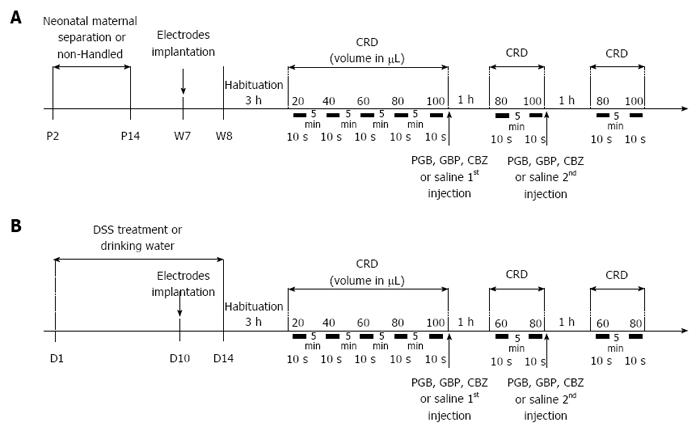Copyright
©The Author(s) 2016.
World J Gastroenterol. Aug 21, 2016; 22(31): 7111-7123
Published online Aug 21, 2016. doi: 10.3748/wjg.v22.i31.7111
Published online Aug 21, 2016. doi: 10.3748/wjg.v22.i31.7111
Figure 1 Experimental design of anticonvulsant treatment assessment on colonic hypersensitivity.
A: Non-inflammatory hypersensitivity was induced by neonatal maternal separation from day 2 to day 14 (P2 to P14). At week seven, electrodes were surgically implanted in abdominal muscle. On week eight, mice were accustomed to restraint device for 3 h before probe insertion for the colorectal distension (CRD). Balloon was inflated from 20 to 100 μL to assess basal colonic sensitivity. Then mice were subcutaneously injected with a first dose of anticonvulsants [carbamazepine (CBZ) 10 mg/kg, gabapentin (GBP) 30 mg/kg or pregabalin (PGB) 10 mg/kg] or saline and colonic sensitivity was assessed 1 h later for the two distension volumes displaying the highest significant differences in visceromotor response (VMR) between control and sensitized groups (80 and 100 μL). A second subcutaneous injection was performed to reach the second dose of anticonvulsants (CBZ 30 mg/kg, GBP 100 mg/kg or PGB 30 mg/kg) or saline and the same protocol was repeated; B: A moderate intestinal inflammation was induced by replacing drinking water by 1% DSS at D1 for 14 d. At D10, electrodes were surgically implanted in abdominal muscle. On the last day of treatment (D14), mice were accustomed to restraint device for 3h before probe insertion for the CRD. Balloon was inflated from 20 to 100 μL to assess basal colonic sensitivity. Then mice were subcutaneously injected with a first dose of anticonvulsants (CBZ 10 mg/kg, GBP 30 mg/kg or PGB 10 mg/kg) or saline and colonic sensitivity was assessed 1h later for the two distension volumes displaying the highest significant differences in VMR between control and sensitized groups (60 and 80 μL). A second subcutaneous injection was performed to reach the second dose of anticonvulsants (CBZ 30 mg/kg, GBP 100 mg/kg or PGB 30 mg/kg) or saline and the same protocol was repeated. CRD: Colorectal distension.
- Citation: Meleine M, Boudieu L, Gelot A, Muller E, Lashermes A, Matricon J, Silberberg C, Theodorou V, Eschalier A, Ardid D, Carvalho FA. Comparative effects of α2δ-1 ligands in mouse models of colonic hypersensitivity. World J Gastroenterol 2016; 22(31): 7111-7123
- URL: https://www.wjgnet.com/1007-9327/full/v22/i31/7111.htm
- DOI: https://dx.doi.org/10.3748/wjg.v22.i31.7111









